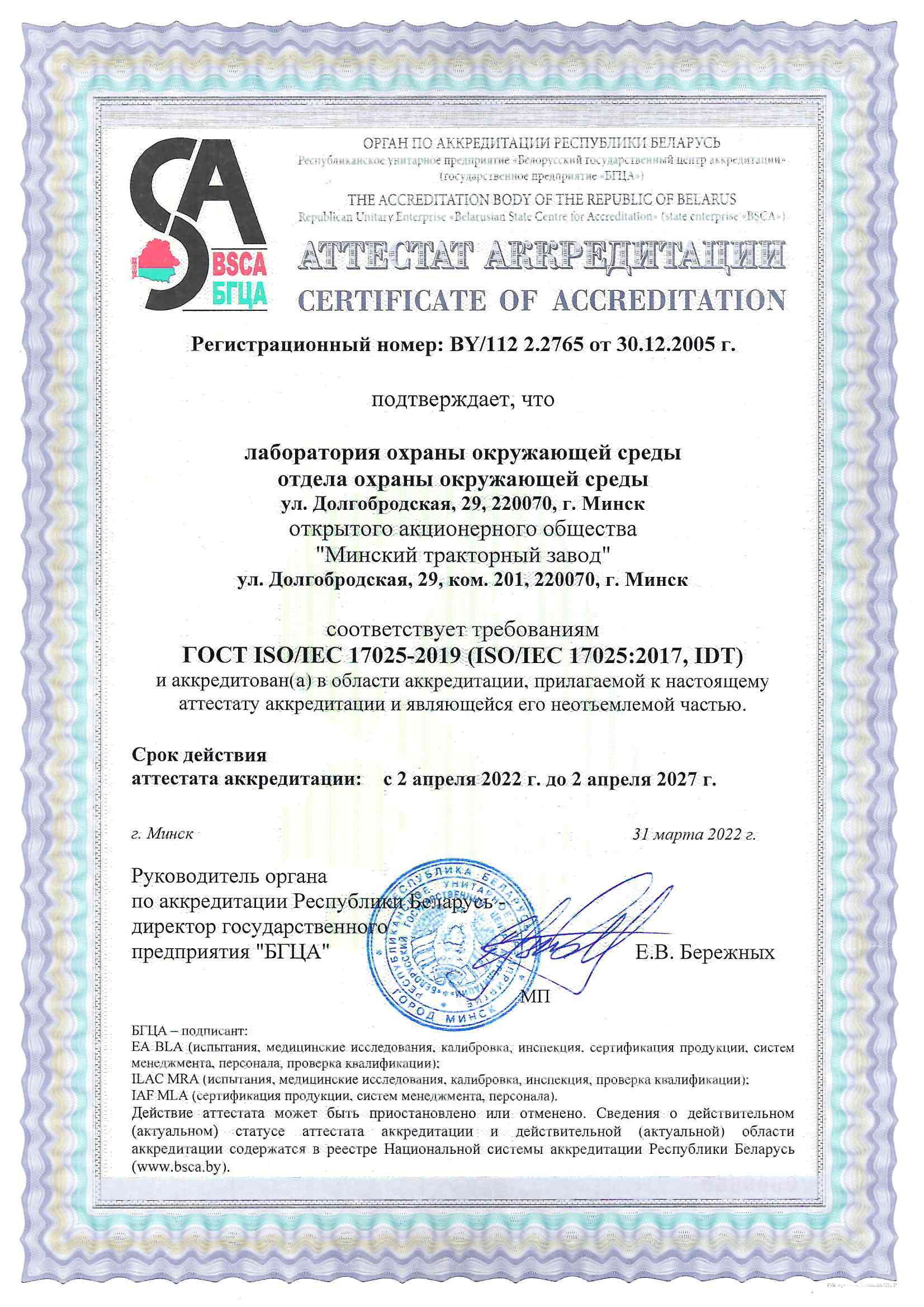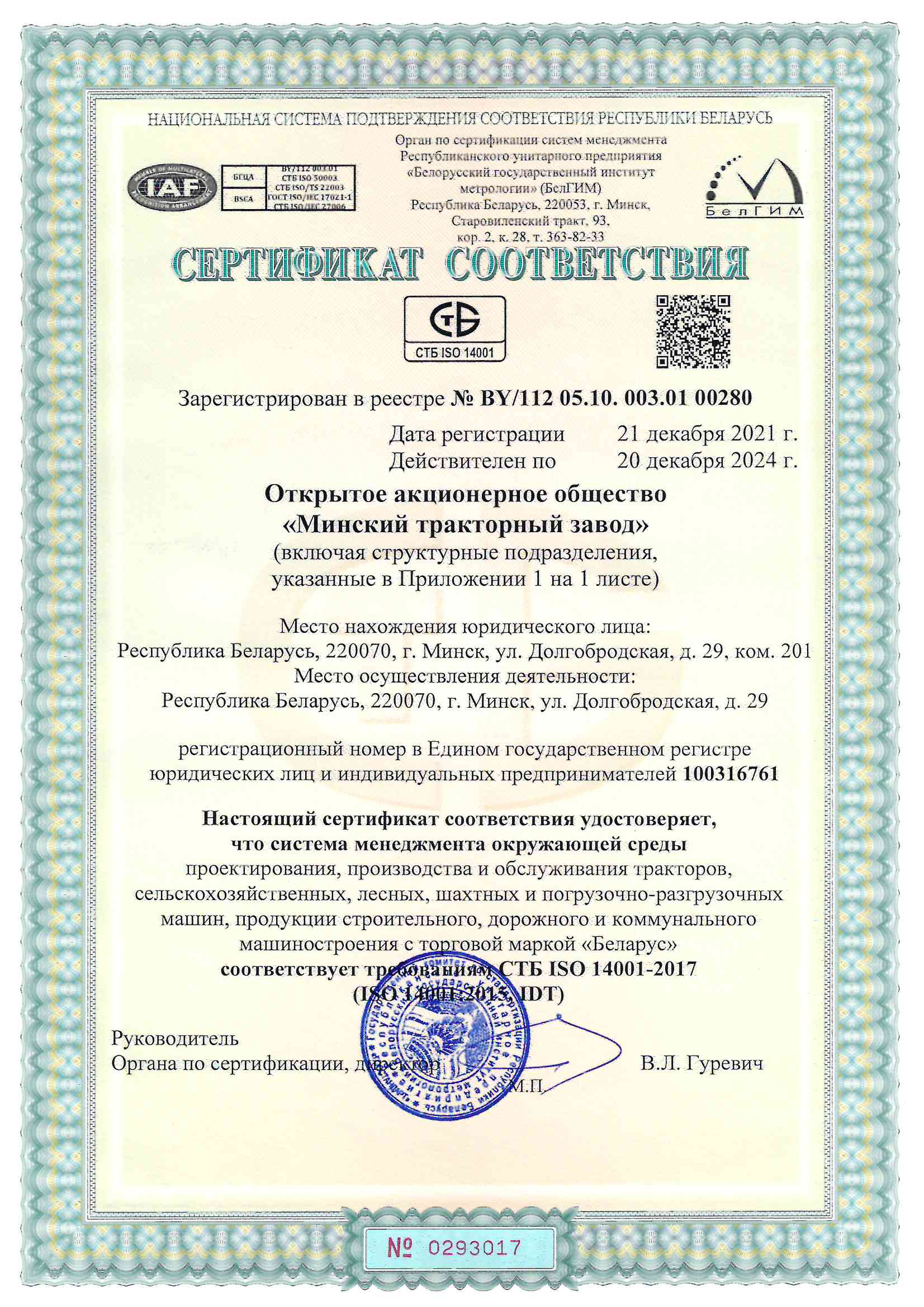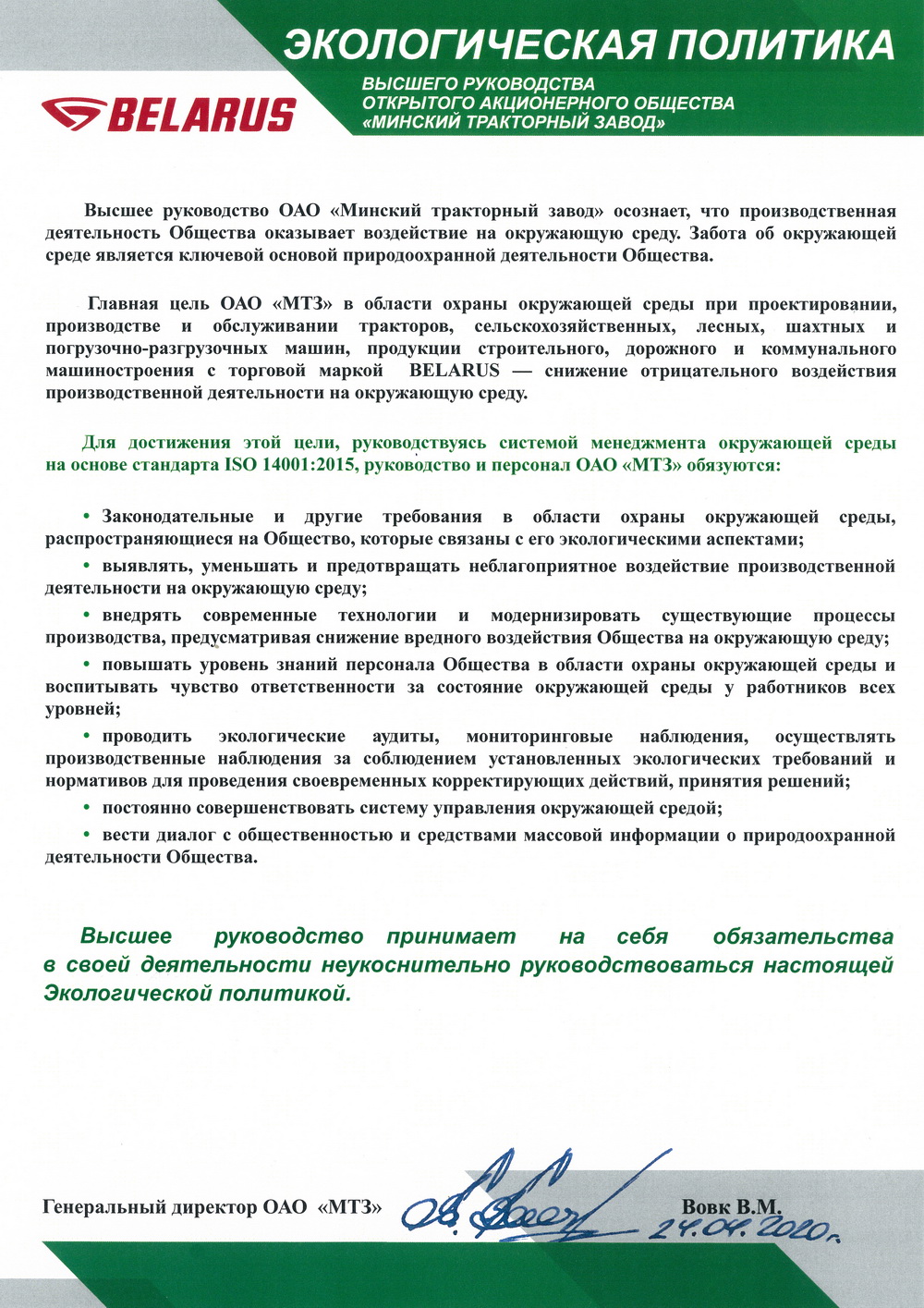Environmental Management System
In 2008, OJSC «MTW» implemented an environmental management system (EMS) in accordance with the requirements of the ISO14001:2004 standard, which was confirmed by the international organization Foreign Limited Liability Company «Bureau Veritas BEL LTD». In 2012, the National Conformity Assessment System issued an environmental certificate of conformity.
The fundamental document of the EMS is the Environmental Policy of the top management of OJSC «MTW», which creates the basis for the enterprise to set its targeted and planned environmental indicators.
In order to fulfill the obligations of the Environmental Policy, the enterprise is working to improve industrial environmental safety, is developing and implementing measures aimed at reducing the volume of production waste, increasing its recycling, protecting the atmosphere, and protecting water resources.
The EMS helps identify aspects of the enterprise's activities that make the greatest environmental impact, determine goals and objectives in environmental protection activities, concentrate resources and develop measures to achieve the main goals and objectives, gradually reduce the enterprise's impact on the environment with the most optimal distribution of costs and constant growth of production.
Industrial waste management
As a result of the production activities of OJSC «MTW» various production wastes are generated, of which only 4% are disposed of at the landfills of the Municipal Unitary Enterprise «Ecores», while 96% are involved in the recycling process. The main industrial waste at the enterprise in terms of volume is the waste from blank production, which accounts for 93% of the total production waste at OJSC «MTW».
The company is making targeted efforts to increase the in-house use of waste. Since 1998, the paint waste recovery site (material storage workshop) has managed the recycling of paste-like waste of primer mixtures. The primers obtained as a result of the regeneration of paint waste are used for priming of castings in the plant’s own foundry.
One of the promising areas for using waste is the processing and use of sludge from treatment facilities of electroplating industries. Together with the Department of Inorganic Chemistry of the Belarusian State Technological University, work was carried out to process the sludge after the treatment of galvanic wastewater. As a result, the technical product «Ferry-hydroxide» (FHO) was obtained: a paste-like material with sorption, coagulation properties and a fluxing effect.
This product is successfully used as a fluxing additive in the production of ceramic and building materials. Technical specifications for the product have been approved by the State Institution «Republican Center for Hygiene, Epidemiology and Public Health».
In the mechanical shop No. 5, MTW implemented the technology of chemical-thermal processing of parts in vacuum with hardening in an inert gas environment using the ModulTherm 7/1 system by ALD Vacuum Technologies GmbH (Germany).
Vacuum processing is the most energy-saving and completely environmentally friendly; and for production personnel, it is the most effective in terms of hygiene and industrial sanitation.
An environmentally friendly inert gas – helium – is used as a quenching medium, thereby ensuring the absence of waste typical for the quenching process: synthetic and mineral oils that have lost their application properties, or a mixture of waste petroleum products (the amount of waste was reduced by 10 tons per year). After heat treatment, there is no need to clean parts by shot blasting, which prevents the formation of waste such as iron-containing dust.
The implementation of planned activities helps significantly reduce the volume of generated waste and maximize the recycling of waste, which ultimately reduces the burden on the environment.
Water conservation
OJSC «MTW» is making efforts to implement measures aimed at protecting water resources.
In order to eliminate heavy metal contamination of wastewater from galvanic production, treatment facilities have been built and are operating in Mechanical workshop No.4, Mechanical-and-assembly shop No.3, and Workshop No.93.
The essence of the ferroferitization method used is the treatment of wastewater with an electrically generated coagulant, ferroferrihydrosol (FFH), obtained from steel waste by electrolysis.
The FFH composition is a highly effective sorbent and coagulant, which also has the properties of a reducing agent and a chemical reagent. FFH purifies water containing almost any set of heavy metals, even in the presence of strong complexing agents. FFH retains its working properties for a year or more and can be used at standard reagent stations. The composition has been tested in a number of European countries and is increasingly applied.
The advantages of FFH are:
- FFH successfully solves the problem of water purification
- in terms of depth of water purification, FFH is much superior to traditional reagents; unlike them, when neutralizing industrial wastewater, it does not cause additional salinization of water, which facilitates its return to production
- FFH is not a chemically aggressive substance and does not pose a danger to the operating personnel of treatment facilities
- сo-precipitation of heavy metals is ensured in the same pH range, which simplifies the process flow and its control
As constant laboratory monitoring shows, the concentrations of heavy metals after galvanic treatment facilities in wastewater do not exceed permissible concentrations.
Air protection
In the field of atmospheric air protection, reducing the burden on the environment is achieved through the introduction of advanced technologies and modernization of existing treatment equipment.
The main sources of pollutant emissions at the enterprise are equipped with gas treatment plants, the operating efficiency of which ranges from 75 to 95 percent.
Introduction of the «Cold-Box-Amin» core manufacturing process in foundries
The core departments of foundries, that operate using thermal drying technology, have the largest impact in atmospheric air pollution with components such as phenol and formaldehyde. In world foundry practice, the "Cold-Box-Amin" process is widely used for curing cores in boxes without heating with blowing with a gas catalyst, dimethylethylamine, which significantly accelerates the reaction and, after upon its completion, leaves the process without changing.
At OJSC «MTW», the «Cold-Box-Amin» process is applied in core making machine by Laempe (Germany), core machines of models 4747 and 4760 of BELNIILIT Institute, and modernized core machines 4509S.
The new process, in contrast to thermal drying, makes it possible to produce cores of complex configurations, solid and hollow, which reduces the consumption of sand by 15-20% and binding materials by 2 times, in addition, gas consumption and the labor intensity of manufacturing the cores are reduced, the process of core manufacturing is automated, casting quality and staff working conditions are improved.
Transferring the production of cores to the «Cold-Box-Amin» process has an undoubted environmental effect, which is reducing emissions of phenol and formaldehyde.
Core machines are equipped with gas cleaning equipment - scrubbers.
Analytical environmental monitoring
In order to ensure systematic environmental control and obtain complete and reliable information on the impact of pollution sources on the environment, local environmental monitoring is carried out.
The company operates an environmental protection laboratory with modern equipment. The laboratory is accredited in all areas of research in the field of environmental protection: determination of pollutants in atmospheric air and air from industrial emissions, in wastewater, surface and groundwater, as well as in company’s soils.
In April 2012, the accreditation certificate of the environmental protection laboratory was confirmed and extended until 2017, which makes the enterprise entitled, in accordance with environmental legislation, to conduct all types of environmental monitoring on its own without the involvement of third parties.



